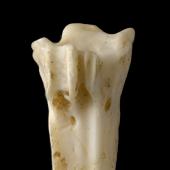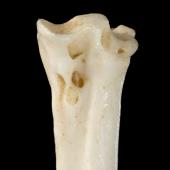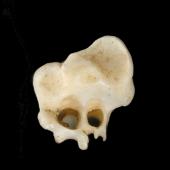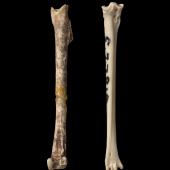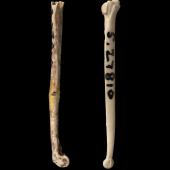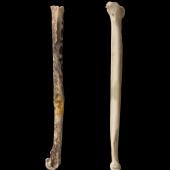North Island stout-legged wren
Xenicus jagmi (Millener, 1988)
Order: Passeriformes
Family: Acanthisittidae
Other names: North Island stoutlegged wren, North Island stout legged wren
Geographical variation: Sometimes considered conspecific with the South Island stout-legged wren P. yaldwyni.
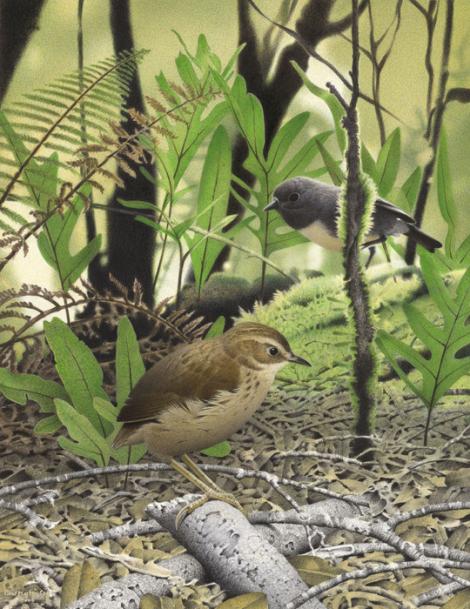
North Island stout-legged wren. Stout-legged wren (Pachyplichas yaldwyni). Image 2006-0010-1/2 from the series 'Extinct birds of New Zealand'. Masterton. Image © Purchased 2006. © Te Papa by Paul Martinson See Te Papa website: http://collections.tepapa.govt.nz/objectdetails.aspx?irn=710964&term=legged+wren
Apart from moas, the bird fauna of New Zealand was thought to be largely a collection of waifs and strays until quite recently. It is only since the late 1980s that the full diversity of the New Zealand wren fauna, our second richest group of landbirds, has become known. When the bones of these small birds were finally examined properly it became clear that there were seven species in five genera living at the time of first human settlement, representing a substantial radiation within the country. The North Island stout-legged wren is one of these recently described birds and, unusually for a song bird, but not so much for a New Zealand wren, it was flightless. It was extinct before European contact. Stout-legged wrens were originally described in their own genus (Pachyplichas); however, genetic analyses showed them to be more closely related to rock wren (Xenicus gilviventris) than either is to bush wren (X. longipes).
Identification
Stout-legged wrens were the largest of the New Zealand wrens, but the North Island species was distinctly smaller than the South Island bird. Recent finds suggest that there may be more size variation than was at first recognised and there may in fact be only one species of stout-legged wren but critical comparisons have not yet been made.
The striking characteristic of the stout-legged wrens was their heavy pelvis and solid leg bones with large muscle attachments. They also had long, stout toes with weakly curved claws. The breast bone had a very small keel and the bones of the pectoral girdle and humerus were slender, suggesting strongly that these wrens could not fly. Compared to other New Zealand wrens the bill was short and stout and the cranium less depressed.
Distribution and habitat
North Island stout-legged wrens have been found in many fossil localities throughout the North Island from Tokerau Beach to the Wairarapa, in situations that suggest they mainly inhabited lowland mixed podocarp and broadleaf forests.
Behaviour and ecology
With their long strong toes and poorly curved claws the feet of stout legged wrens suggest that they mainly stood on flat surfaces, presumably the ground, logs and stumps rather than perched on twigs and branches. Their strong, well-muscled legs would give them good mobility near ground level.
Websites
References
Millener, P.R. 1988. Contributions to New Zealand’s late Quaternary avifauna. 1: Pachyplichas, a new genus of wren (Aves: Acanthisittidae), with two new species. Journal of the Royal Society of New Zealand 18: 383-406.
Mitchell, K.J.; Wood, J.R.; Llamas, B.; McLenachan, P.A.; Kardailsky, O.; Scofield, R.P.; Worthy, T.H. & Cooper, A. 2016. Ancient mitochondrial genomes clarify the evolutionary history of New Zealand’s enigmatic acanthisittid wrens. Molecular Phylogenetics and Evolution 102: 295–304.
Tennyson, A.; Martinson, P. 2006. Extinct birds of New Zealand. Te Papa Press, Wellington.
Recommended citation
Southey, I. 2013 [updated 2022]. North Island stout-legged wren. In Miskelly, C.M. (ed.) New Zealand Birds Online. www.nzbirdsonline.org.nz
North Island stout-legged wren
- Breeding season
-
- Jul
- Aug
- Sep
- Oct
- Nov
- Dec
- Jan
- Feb
- Mar
- Apr
- May
- Jun
- Egg laying dates
-
- Jul
- Aug
- Sep
- Oct
- Nov
- Dec
- Jan
- Feb
- Mar
- Apr
- May
- Jun




